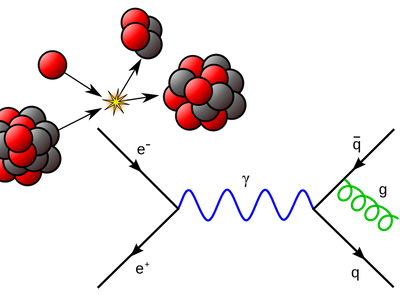SH2103 Subatomic Physics 7.5 credits

In this course you get to dive into the world of subatomic physics where exciting phenomena from quantum mechanics and the theory of relativity meet. It introduces you to nuclear physics, where the atomic nucleus is studied, and particle physics which describes the smallest constituents of our universe, the elementary particles. The course is centered around 18 lectures, two laboratory exercises where current research methods are used to analyze real data from nuclear and particle physics experiments, and two simpler sets of take-home problems.
Choose semester and course offering
Choose semester and course offering to see current information and more about the course, such as course syllabus, study period, and application information.
Application
For course offering
Autumn 2024 Start 28 Oct 2024 programme students
Application code
51407
Content and learning outcomes
Course contents
The course is focused on the physics that describes processes on the subatomic scale, nature's smallest building blocks and the forces through which they interact. Basic models of the atomic nucleus, neutrons, protons, quarks, and leptons will be studied, including the Standard Model of particle physics. The fundamental forces acting on the particles will be discussed, as well as the mediator particles for these interactions. Binding energy, limits of stability, radioactive decay, and radiation are also explained. Feynman diagrams will be introduced to describe processes between elementary particles, e.g. decays. The above parts are then applied to discuss the origin and nature of the universe, including the Big Bang, nucleosynthesis, stellar evolution, and dark matter. The course also introduces experimental facilities and methods used in today's research in nuclear and particle physics. Two laboratory exercises give hands-on experience of studying phenomena with atomic nuclei and elementary particles.
Intended learning outcomes
After passing the course, the student must be able to:
- Describe basic properties of atomic nuclei, e.g. mass, size, binding energy and radioactive decay.
- Explain the origin of ionizing radiation (α, β, γ, etc), and use mass and binding energy of a nucleus to assess its stability against various decays.
- Classify and describe different types of nuclear reactions, including fission and fusion.
- Describe nucleosynthesis processes and their relation to element abundances. 2021-10-13 2 (3)
- Explain the solutions of the shell model by using different model potentials, explain the appearance of magic numbers, and give examples of collective excitations of the nucleus.
- Use standard reference material (the nuclide chart and the table of isotopes) in order to solve problems and to interpret the measured data.
- Define the particle content of the Standard Model (SM) organized in a structured manner, including the properties of the particles and statements about what fundamental interactions they take part in.
- Describe and qualitatively analyze processes with fundamental interactions between elementary particles through the use of Feynman diagrams and conservation laws.
- Demonstrate understanding of how leptons, photons and hadrons interact with matter, and how detectors can be used to measure elementary particles in experiments.
- Give accounts of historic discoveries of particles, interactions and phenomena in nuclear and particle physics.
- Identify shortcomings of the SM in terms of relevant experimental observations that it fails to explain, and describe experiments searching for evidence for physics beyond the SM.
Literature and preparations
Specific prerequisites
Modern physics, SH1014 or equivalent.
English B / English 6
Recommended prerequisites
Equipment
Literature
Examination and completion
If the course is discontinued, students may request to be examined during the following two academic years.
Grading scale
Examination
- LAB1 - Laboratory work, 1.0 credits, grading scale: P, F
- TEN1 - Examination, 6.5 credits, grading scale: A, B, C, D, E, FX, F
Based on recommendation from KTH’s coordinator for disabilities, the examiner will decide how to adapt an examination for students with documented disability.
The examiner may apply another examination format when re-examining individual students.
Written exam: TEN1
Laboratory exercises with written reports: LAB1
Opportunity to complete the requirements via supplementary examination
Opportunity to raise an approved grade via renewed examination
Yes
Examiner
Ethical approach
- All members of a group are responsible for the group's work.
- In any assessment, every student shall honestly disclose any help received and sources used.
- In an oral assessment, every student shall be able to present and answer questions about the entire assignment and solution.